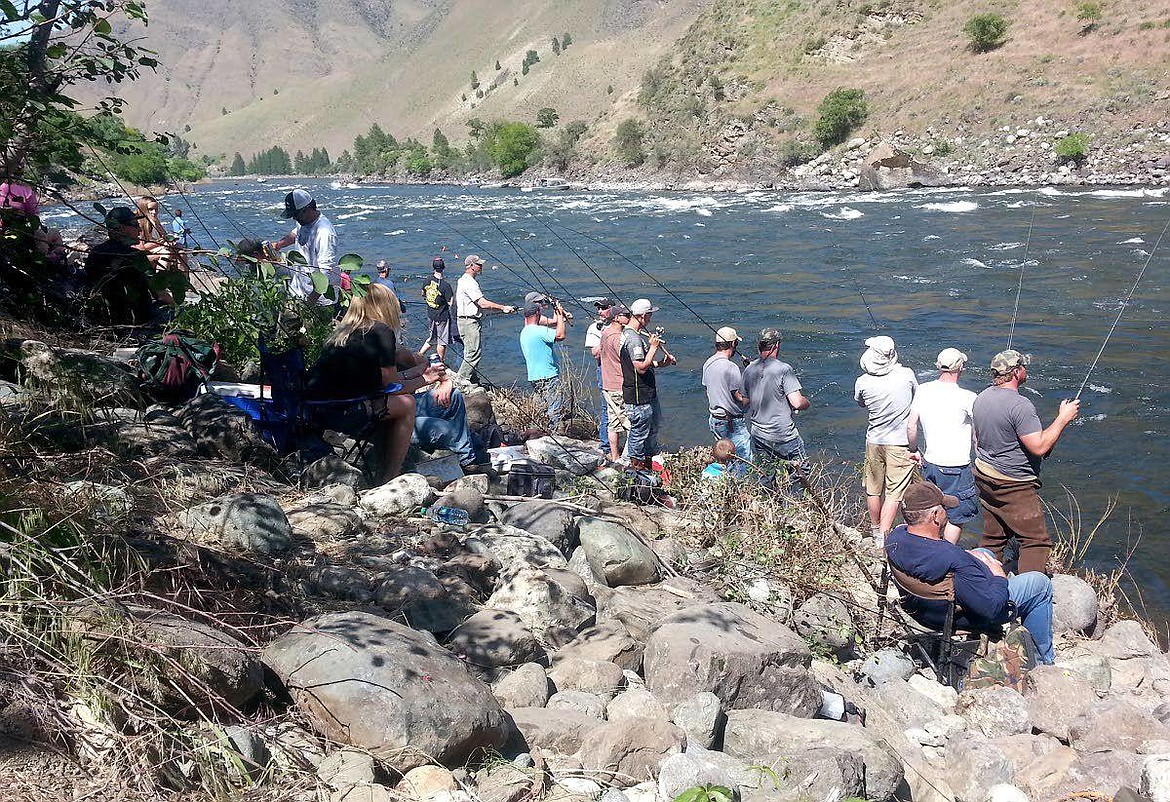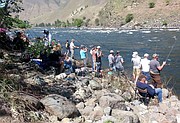IDFG warns anglers to heed social distancing
Eric Barker | Hagadone News Network | UPDATED 5 years, 7 months AGO
as popular spring chinook fin to local rivers
Spring chinook fishing season opened on some Idaho rivers last week amid stay-at-home orders that allow for outdoor recreational activities.
Officials from the Idaho Department of Fish and Game are asking anglers to heed social distancing protocols as they head to their favorite springer holes. At least thus far, the fish are making it easy.
Through Wednesday, only 2,298 spring chinook had been counted at Bonneville Dam on the Columbia River and just 22 at Lower Granite Dam, the last barrier the fish must cross on their return from the Pacific Ocean.
The low number of fish over Lower Granite is not unexpected. The 10-year average there is about 170 adult spring chinook. But the run has been trending later and later in recent years. So far, the 2020 run is ahead of the past three runs, which were all exceptionally weak.
This year’s run is also expected to be weak, and the early numbers reflect that.
“It hasn’t swayed my thoughts that it won’t be different than the preseason forecast which is a down run but enough to provide fisheries,” said Joe DuPont, regional fisheries manager for the Idaho Department of Fish and Game at Lewiston.
The run is expected to produce harvest shares of about 1,000 adult fish on the Clearwater River, 1,600 on the lower Salmon and Little Salmon rivers and about 300 on the Snake River in Hells Canyon.
The early fishing is generally concentrated on the lower Clearwater, where anglers have plenty of room to spread out, but as the season progresses the fish will push into areas where anglers tend to congregate in high numbers. Places like “The Wall” below Dworshak Dam and along the lower Salmon and Little Salmon Rivers near the town of Riggins.
DuPont said the agency will monitor fishing seasons and the degree to which anglers are able to social distance themselves. If they are unable to, he said it is possible some areas will be closed to fishing.
“This year, more than ever, we need cooperation and understanding on the part of all anglers to keep everyone safe and to keep areas open to fishing,” he said.
The department will check in frequently with riverside communities to make sure they are comfortable with angler behavior. The city of Riggins has asked the agency to keep a close eye on anglers in the section of the lower Salmon River that passes through the small town. When spring chinook fishing is hot, anglers crowd into the town and occupy its parking lots, Riggins City Park and line up shoulder to shoulder along the river.
Roy Akins, a member of the Riggins City Council and a fishing outfitter said the town will ask the departament to close fishing between the Time Zone Bridge and Short’s Creek if angling becomes too crowded. The ask won’t be made lightly.
“It’s totally against what Riggins is about,” Akins said. “We are the backyard of Idaho, and we want people to feel comfortable and welcome here. We are famous for it.”
For now the department is leaving the stretch open but has agreed to educate anglers about the concerns of people at Riggins and other communities and how they can help reduce the spread of the virus even while fishing.
DuPont said those fishing in areas prone to congestion can do things like fish for short periods of time and then allow others to use the spot. He is also encouraging people to think about how they will land a chinook if they hook one. He said anglers in congested areas may want to assign one person as the netter so multiple people are not handling a communal net. Hand sanitizer should also be used after handling nets or other items where the disease may be lurking.
Anglers can also protect the small towns they visit by being well provisioned with food and other supplies when they arrive.
People who boat fish should think about doing so with members of their own households and take care to avoid mingling at pinch points such as boat ramps.
Akins takes clients fishing in his drift boat and said he has worked out a system to maintain proper distances. He plans to screen clients to make sure they are from the same households and not experiencing COVID-19 symptoms. He has moved his seat further to the stern of the boat to keep space between him and the clients.
“We feel confident we can get people out in the boat and maintain the standards,” he said.
Akins said people who like to fish the Little Salmon River may want to consider fishing further upstream. Most of the angling happens between Riggins and the mouth of Rapid River. But he said in recent years more fish have been released as juveniles above the mouth of Rapid River and return there as adults.
“This would be a great year to take that opportunity to spread out and take advantage of the upper Little Salmon that has salmon in it but nobody is fishing for,” he said.
More information about recreating in Idaho’s outdoors during the pandemic is available at https://coronavirus.idaho.gov/recreate-responsibly/.
Fisheries officials in Washington have not yet set spring chinook seasons on the Snake River. The state remains closed to hunting and fishing because of the COVID-19 pandemic.
Barker is the Outdoor editor of the Lewiston Tribune. He can be reached at [email protected]
ARTICLES BY ERIC BARKER
Donaldson: Lewiston schools to close
The Lewiston and Lapwai school districts made the sudden decision Sunday to close schools today as a precautionary measure aimed at slowing local spread of the coronavirus.
Groups want more time to comment on river plan
A little more than a week after the federal government unvieled its massive draft environmental impact statement on the Columbia River Hydropower System and its effects on salmon and steelhead, some interest groups are asking for more time to formulate their public comments and questioning if public hearings should be delayed because of the coronavirus outbreak.
Washington prepares to close schools
School superintendents in southeastern Washington scrambled Friday to scrape together emergency plans following the announcement from Gov. Jay Inslee that all public and private schools in the state will shut down by Tuesday and stay closed through April 24 in an effort to stem the spread of the coronavirus.



